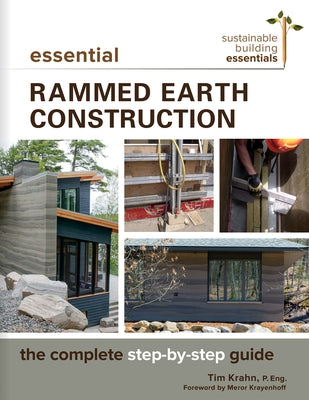Description
Everything you need to know to build with rammed earth in warm and cold climates.
Rammed earth - sand, gravel, and clay or lime/cement binder packed into forms - is a low-energy, high-performance building method, yielding beautiful, sustainable results. It's thermally stable and can be insulated, can actively modulate humidity, provides a healthy indoor environment, and allows site materials to be used for major structural and building envelope elements.
Essential Rammed Earth Construction covers design, building science, tools, and step-by-step building methods for any climate, with a special emphasis on building in cold climates of the northern US, Canada, and northern Europe. Coverage includes:
- Overview of earthen building
- Appropriate use of rammed earth walls
- Stabilized versus raw rammed earth
- Design considerations, including structural, insulation, and building envelope details
- Special considerations for cold and freeze-thaw climates
- Construction drawings, with step-by-step building instructions
- Tools and labor covering industrial methods, low-tech techniques, formwork options, mix design, budgets, and schedules
- Codes, inspections, and permits.
This guide is an essential resource for experienced builders, DIY home owners, designers, engineers, and architects interested in learning about rammed earth construction.
Author: Tim J. Krahn
Publisher: New Society Publishers
Published: 01/01/2019
Pages: 160
Binding Type: Paperback
Weight: 1.20lbs
Size: 10.90h x 8.40w x 0.60d
ISBN13: 9780865718579
ISBN10: 0865718571
BISAC Categories:
- House & Home | Do-It-Yourself | General
- Technology & Engineering | Construction | General
- House & Home | Design & Construction
About the Author
Tim J. Krahn, P. Eng. is a registered professional engineer and partner in Building Alternatives Inc., a consulting engineering company specializing in non-conventional structural and building envelope engineering with an emphasis on natural materials and energy efficiency. He holds a masters degree in geotechnical engineering and a bachelors degree in civil engineering from the University of Manitoba, and is a founding member of the Natural Building Engineering Group, the current chair of the Ontario Natural Building Coalition, and is active on the Renewable Materials task force of the Embodied Carbon Network. He received the first building permit for a rammed-earth structure in the city of Ottawa, and has been the structural engineer on more than twenty rammed-earth projects in Canada, including the first net-zero municipal building in Ontario, the Oxford County Municipal Solid Waste Office and Education Centre. He currently resides in Ontario, Canada.

